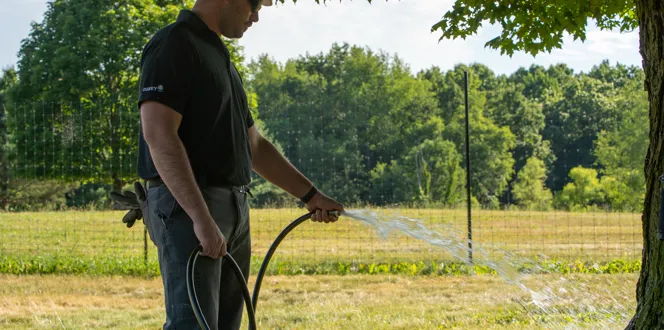Wintertime brings out the rawest version of our trees. They’re bare. They’re exposed. And they must survive in harsh, dry air amidst bitter cold temperatures.
So, do they need any help from us to stay warm? Damian in Chicago asked, “Do I need to cover my Japanese maple tree in winter?”
No matter what type of tree you have, here’s when you should step in and protect your tree from winter’s most extreme elements.
What You Need to Know About Wrapping Trees for Winter
If you have a new tree, a tree with thin bark, or an arborvitae, you should wrap it before Jack Frost arrives in town.
Do trees need winter protection? What about evergreens?
Young trees, or trees of any age with thin bark, benefit from winter protection. Why, you ask?
Well, whenever the sun peeks out on a chilly winter day, it warms the tree’s bark. Then, the tissue below the bark perks up. But as soon as the sun disappears behind a building or cloud, the bark temperature quickly drops, which may kill the tissue and can leave the bark cracked and dry.
That, my friends, is what we call sunscald. But if you wrap your delicate trees, you help protect them from it!
A similar scare can happen to evergreens in winter. Their needles soak up the sunlight on warm winter days, but as soon it gets cool again, the foliage can dry out and turn from fresh green to stale brown.
What's the best tree wrap for winter? Is it burlap?
It depends on what kind of tree you have.
Take Damien’s Japanese maple, for example. It’s a tree that loses its leaves in the fall and has thin bark, so the best way to protect it is by wrapping the trunk in a plastic tree guard.
The same goes for any thin-barked tree, like maple, poplar, aspen, sycamore or linden. Ditto for any newly-planted tree that loses its leaves. Wrap the trunk from the base up to the lowest branches to help protect it from sunscald.
But if you have an arborvitae or evergreen with one of the below issues, wrap it with burlap instead.
Wrap burlap around your evergreen if it’s…
- Weak for any reason.
- Fully exposed to heavy wind.
- Dehydrated and didn’t get much water this fall.
- Newly planted.
How do I use tree wrap to wrap trees, like arborvitae, with burlap?
There are two ways to safeguard your evergreen tree with burlap. Not only will it help keep the cold air out, but it may also stop deer from eating it!
Option one:
- Loosely wrap burlap all the way around the tree, from the lowest branches to slightly above the highest peak.
- Pin the burlap temporarily, cut from the spool and remove pins.
- To secure, use twine to tie the top, middle and bottom of the tree.
Option two:
- Grab three wooden stakes that are slightly taller than the tree.
- Place one stake in front, one on the side of the tree that gets the most wind, and the final one on either side of the tree. You want to form a triangle.
- Stretch a few pieces of burlap across the stakes and secure with staples.
- When you’re done, you’ll have what looks like a protective fence around your tree.





